
Dudleya lanceolata is a succulent plant known by the common name lanceleaf liveforever or lance-leaved dudleya. It is an extremely variable and widely ranging species that occurs from Monterey County and Kern County in California south through Ensenada in Baja California. It is characterized by green to purple lanceolate leaves, red, orange, or less commonly yellow petals, and is typically tetraploid. Despite its diversity, it is quite stable as a species, but hybrids may be discovered with other species of Dudleya, which can make it difficult to discern in areas where numerous species converge.
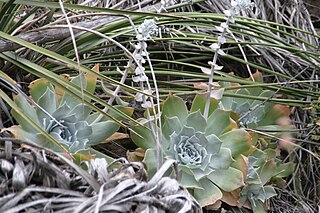
Dudleya pulverulenta is a species of perennial succulent plant known by the common names chalk lettuce, chalk dudleya, and chalk liveforever. It is one of the largest Dudleya, with a silvery, waxy rosette that may greatly contrast with its habitat. It is also regarded as one of the most distinctive members of the Dudleya, with one of the most specialized inflorescences in the genus, adapted to hummingbird pollination through its red pendent flowers, the longest corolla, and the highest nectar output. Dudleya pulverulenta has the largest range of all Dudleya, over 1,000 kilometres (620 mi), being found from southern Monterey County in California to the Sierra de San Borja in southern Baja California. It is closely related to Dudleya arizonica, a smaller desert species that tends to lack the specialized floral traits, and Dudleya anthonyi, which differs in a few morphological traits and is restricted to the San Quintín Volcanic Field.
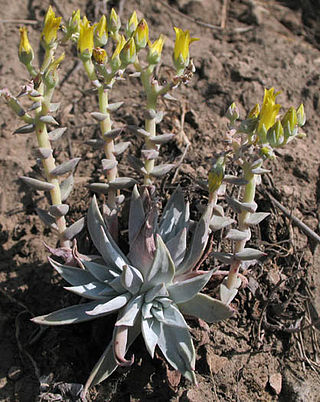
Dudleya verityi is a rare species of succulent plant known by the common name Verity's liveforever. It is endemic to Ventura County, California, where it is known from only three occurrences in the vicinity of Conejo Mountain between Camarillo and Thousand Oaks. It probably occurs in a few additional locations nearby which have not yet been officially vouchered.

Dudleya attenuata is a species of perennial succulent plant known by the common name taper-tip liveforever, native to Baja California and a small portion of California. It is a rosette-forming leaf succulent which has narrow pencil-shaped leaves that can often be found covered in a white epicuticular wax. The thin, sprawling stems branch to form the clusters of rosettes, with plants creating a "clump" up to 40 cm wide. The small flowers are white or yellow, with 5 spreading petals. It is a diverse, variable species that extends from the southernmost coast of San Diego County to an area slightly north of the Vizcaino Desert, hybridizing with many other species of Dudleya in its range. Some plants with white or pinkish flowers were referred to as Orcutt's liveforever, referring to a former subspecies split on the basis of the flower color.

Dudleya ingens is a species of perennial succulent plant in the family Crassulaceae commonly known as the rock liveforever or Baja liveforever. A relatively large member of the genus Dudleya, this species has long green succulent leaves, and in April to June is characterized by pale yellow to white pink-tinged flowers topping tall, reddish inflorescences. It has a stem clothed densely with old, leathery leaves, and the inflorescence may be nodding, with the floral branches bearing the flowers tending to unfurl like the fronds of a fern. It is similar in appearance to Dudleya brittonii, but differs in range and chromosome number. This species is endemic to the state of Baja California in Mexico, being found from Santo Tomás to the southern coast of the state.
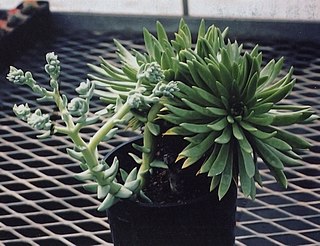
Dudleya guadalupensis is a very rare species of succulent perennial plant in the family Crassulaceae commonly known as the Guadalupe liveforever. It is a rosette-forming leaf succulent, with foliage that is variously colored light green, green, and a waxy white. It is characterized by dense leaves that fold over the center in dormancy, a curving, sinuous flower stalk, and white, cup-shaped flowers. It is endemic to the rocks and islets off of Guadalupe Island, an isolated volcanic island in the Pacific Ocean located 241 kilometers off of the coast of Baja California.

Dudleya rigida is a species of succulent perennial plant in the family Crassulaceae known commonly as the La Laguna liveforever. Characterized by a tall inflorescence with pendant yellowish-red flowers, it is a very rare plant whose existence was doubtful until botanist Reid Moran accidentally re-discovered it. It is endemic to the highest peaks of the Sierra de la Laguna in Baja California Sur, Mexico.

Dudleya pauciflora is a species of succulent plant in the stonecrop family known by the common name few-flower liveforever. It is characterized by its small crowded rosettes of narrow leaves and its colorful inflorescence with red-yellow flowers. Found growing on rocky outcrops and cliffs in the high elevation mountains of the Sierra de San Pedro Martir and the Sierra de San Borja, it is endemic to the state of Baja California, Mexico.

Dudleya gatesii, known by the common name as Gates'liveforever, is a species of perennial succulent plant in the family Crassulaceae. It is native to the central desert of the Baja California peninsula, found growing along dry and rocky outcroppings. It is characterized by red inflorescences topped with white flowers, bracts that are often reflexed downwards, and a rosette of dark-green leaves turning reddish.

Dudleya linearis is an insular succulent plant known by common name as the San Benitos liveforever. It is a rosette-forming perennial characterized by its long, flat green leaves on clustered heads and its yellow flowers. It is endemic to the western island of the Islas San Benito, a small Mexican archipelago in the Pacific Ocean west of Cedros Island. The limited population of the species is vulnerable, and has twice come close to extinction from introductions of grazing animals.

Dudleya cultrata is a species of perennial succulent in the family Crassulaceae commonly known as the knife-leaved liveforever or the maritime succulent liveforever. This species is characterized by oblong, narrow green leaves and flowers with pale yellow petals that bloom from April to June. Although similar to Dudleya ingens, this species is most often seen growing sympatric with the larger, wax-covered Dudleya anthonyi. It is native to Baja California, occurring on the coast from Punta Colonet and San Quintin to El Rosario.
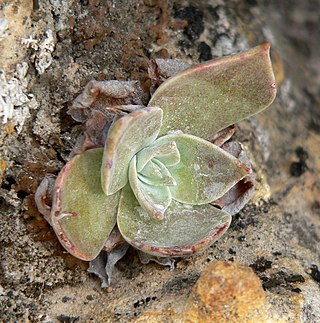
Dudleya arizonica is a species of perennial succulent plant commonly known as the Arizona chalk dudleya and the Arizona liveforever. A member of the genus Dudleya, this species is characterized by long, red flowers that adorn a waxy rosette of succulent leaves. It resembles a reduced desert form of the more coastal chalk dudleya, Dudleya pulverulenta, but differs in its smaller stature, lower number of leaves, and orientation of the flowers. Native to the southwestern United States and northwestern Mexico, it is widespread in range, but is primarily found in scattered, widely separated localities. It can be found as far west as coastal Ensenada to the desolate desert ranges of Nevada. It is one of two species of Dudleya that occur in Arizona, the other being Dudleya saxosa subsp. collomiae, and is the only species on mainland Mexico and in Utah.

Dudleya acuminata is a species of succulent perennial plant in the family Crassulaceae known by common name as the Vizcaino liveforever. A rosette-forming leaf succulent, it has reddish yellow flowers that emerge from April to May. It is native to the Pacific coast of the Vizcaino Desert on the Baja California Peninsula, and on neighboring islands.
Dudleya rigidiflora is a very rare species of succulent perennial plant known by the common name Playa Maria liveforever, endemic to the coast of southwestern Baja California.

Dudleya nubigena is a species of succulent plants in the family Crassulaceae. It is a rosette forming perennial with flattish leaves. Endemic to southern Baja California Sur, the species is found in the Sierra de la Laguna and the surrounding lowlands, a small southern portion of the Sierra de la Giganta, and on Isla Espíritu Santo, with a subspecies endemic to Cerralvo Island.

Dudleya abramsii subsp. abramsii is a species of succulent plant in the family Crassulaceae known by the common name as Abrams' liveforever. It is a small, delicate plant found growing among rocks, and is characterized by yellow flowers with a red tinge that emerge from May to July. It is native to the southern Sierra Nevada of California and the Peninsular Ranges across both the United States and Mexico.
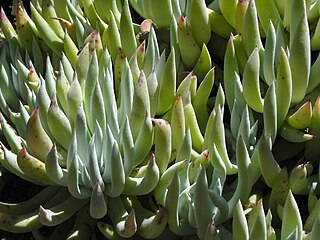
Dudleya albiflora, known by the common name white-flower liveforever, is a species of succulent perennial plant in the family Crassulaceae. It is native to the Baja California Peninsula. This species represents numerous populations with varying chromosome numbers scattered around the peninsula, but all share broad, common morphological traits such as white flowers and narrow leaves.
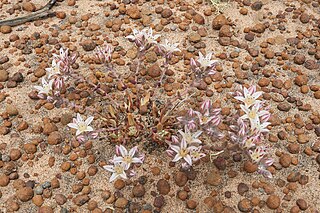
Dudleya crassifolia is a species of drought deciduous, corm-forming succulent plant known by common name as the thick-leaf dudleya. It is an incredibly rare and cryptic plant native to one small locale less than a hectare in area on the Colonet peninsula in Baja California. It is threatened by urban development, including a proposed seaport. It is characterized by white, spreading flowers with leaf bases that are persistent on the stem. Although it did not receive as much media attention as the neighboring Dudleya hendrixii, it has been noted that the plant has several similarities to cryptic succulents like Anacampseros.

Dudleya cymosasubsp. cymosa is a subspecies of succulent perennial plant in the family Crassulaceae endemic to California. It is the autonymous subspecies for Dudleya cymosa, and is known by the common name canyon liveforever. It is native to the California Coast Ranges, the Sierra Nevada and the Santa Monica Mountains. It is characterized by bright-yellow, orange or red flowers and broad, wide leaves. This plant is commonly found growing on rocky outcrops, talus slopes, and in shaded canyons.

Dudleya cymosasubsp. agourensis, commonly known as the Agoura Hills dudleya or Agoura Hills liveforever, is a species of perennial succulent plant. A rare and critically imperiled species from the Santa Monica Mountains in California, it is characterized by glaucous, gray-purple leaves, bright yellow flowers, and ascending bracts. A leaf succulent, it is found growing on west to northwest-facing open, rocky volcanic slopes.




















